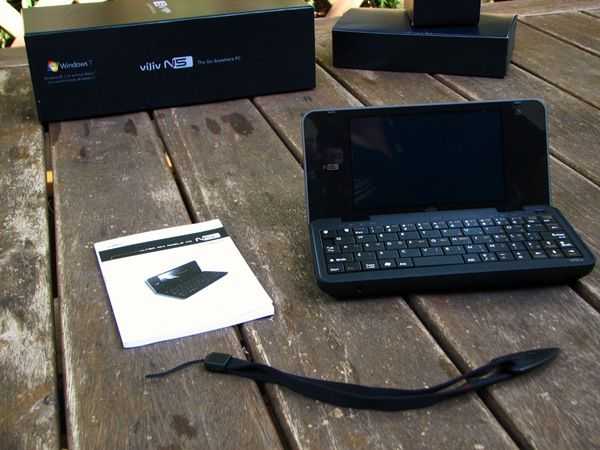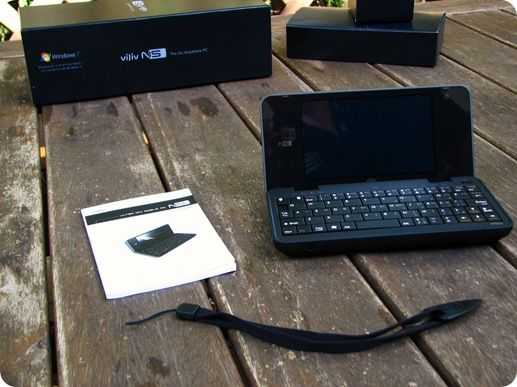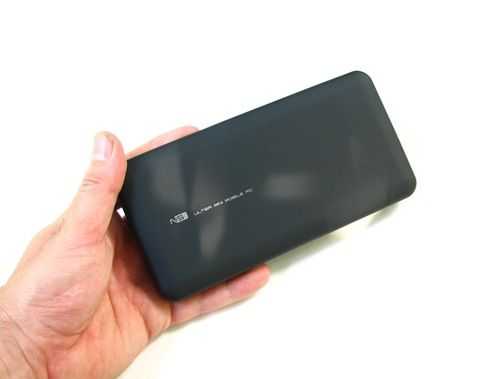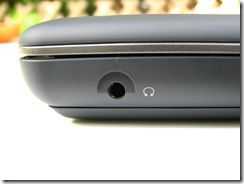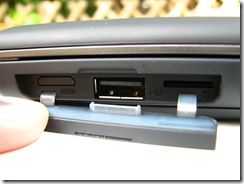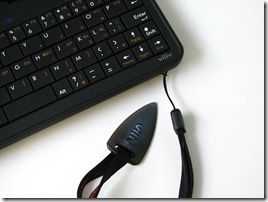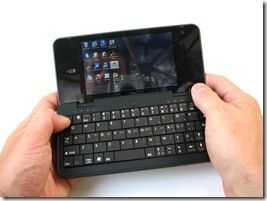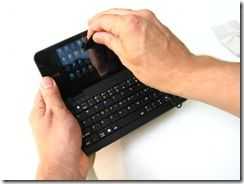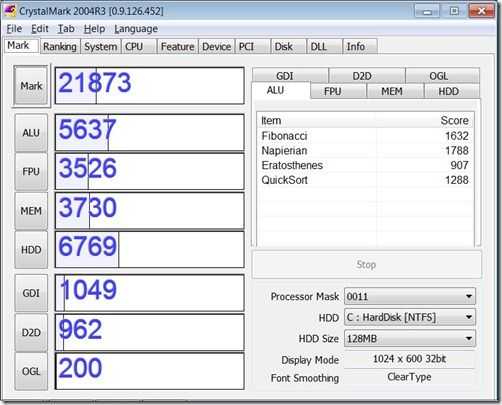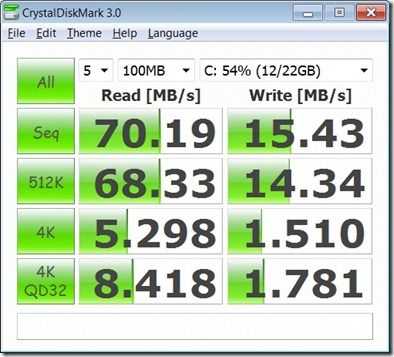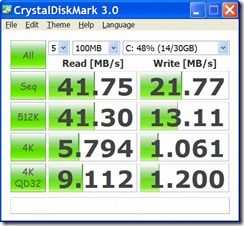The tech blogs of the western world are literally full of slate, pad and tablet talk. ‘Smart’ this or ‘App-store’ that; There’s nothing like a new and controversial product category to get traffic flowing. Meanwhile, sitting in the background and forming a nuclear part of the handheld category of computing devices are the UMPCs that have been serving pro-mobile, industry and education users for many years. Consumers generally aren’t interested in a device targeted at getting work done while on the move but maybe that will change with the smooth-looking Viliv N5 which is meeting many of our expectations and could teach the ‘pads’ a few tricks too.
Viliv N5 specifications, discussion, links, videos and images in the community specifications page.
First five minutes.
I could almost copy and paste the ‘first five minutes’ overview from the Viliv S5 because it was almost the same. In fact the packaging was even better this time round. It’s a shame there was no case included but the unit itself more than makes up for that. It has velvety smooth black rubberized plastic, rounded edges, an extremely clean look all over (the slab battery slots in and forms the back of the unit) and on opening the unit you’re pleased at the feel of the keyboard as you instinctively give it that mock thumbing action. Taking the Windows 7 and Intel Atom stickers off improves the look (as always!) but exposes the huge frame that exists around the 5 inch screen. Its somewhat disappointing to see so much unused space on either side of the screen.
Open Review Videos.
We often record a live, open review of devices and the Viliv N5 was no exception. in 2hrs with JKKMobile and a hundred or so more people interacting live via a chat session we went over the device and exposed the good and bad. All the videos from the live session are available, unedited, here. Check back regularly on UMPCPortal and Carrypad for news about more live sessions.
We also have an N5 review video available on YouTube.
Specifications
The Viliv N5 is based on the Intel Menlow platform that includes the Z520 Atom CPU at 1.3Ghz and the ‘Poulsbo’ chipset which includes a GMA 500 GPU and video decoding hardware. It runs Windows 7 Home Starter operating system. On the review model we had a 32 GB SSD and 1GB of RAM. There’s Wi-Fi, Bluetooth, the GPS module, stereo speakers, a 1024×600 glossy, LED-backlit resistive touchscreen and a built-in 3G module to make the device truly mobile. The battery is a slim 16wh unit.
Full specifications can be found on the product page.
From the outside.
As mentioned above, the N5 is a very clean and stylish looking unit with a rubberized plastic finish and a shaped slab-battery that forms the rear of the device in a very similar way to the old OQO Model 02 that the N5 could be compared with. All ports except the headphone port are covered which again helps to make the device look clean. In the hand, the N5 suffers from being rather dense. It is, of course, lightweight coming in at 400gm / 14oz but due to its size, feels like a solid package. The comparable UMID BZ is noticeably lighter. If its anything like the Viliv X70 though, it will be due to strong casing. Only time will tell on that but checking the hinge and hearing from Viliv that the screen is covered with a hardened glass seems to confirm it. Opening the device could be easier though and the hinge does seem to be a bit tight.
Don’t expect the full range of netbook-style ports on the N5. Although you’ve got a USB, headphone and microSD slot, there’s no Ethernet and importantly, no analogue video out. It’s a surprise omission from a device that could have been a real Swiss-army knife for traveling salespeople. A USB-VGA dongle is the only option if you want to use the N5 to show presentations. The 3G SIM card slot (connecting to a 5.6/7/2 Mbps and voice-capable Huawei EM 770W) is located behind the battery. Voice capability is included and working. SMS capability is also included in the Mobile Partner software.
Full image sets in the Viliv N5 gallery.
The rubberized plastic finish is relatively resistant to finger grease but you’ll still need to carry a cloth if you want the device to remain smudge-free.
Controls
One of the things we really missed on the Viliv S5 was a mouse pointer. Using a 5 inch screen as a tablet is fine but can be difficult when the operating system isn’t designed for it or even aware that the screen DPI is very very tight. This is where a thumb-controlled mouse pointer comes into it’s own. The pointer on the N5 is an optical type which is accurate and easy to use. It’s much easier to use than the equivalent on the UMID BZ and makes the touchscreen less of a critical point which it could have been if the mouse pointer were not there. It’s a relatively heavy-touch resistive layer that we don’t find enjoyable or easy to use. It’s good enough for fingernail scrolling in Firefox (using Grab and Drag) but can be difficult for many operations. [Tip: Switch the screen display settings to 125%to get large icons and easier-to-hit Window elements.] You do have the ‘pick’ pointer though (below) which is a handy way to get some relatively accurate action on the screen. Having options is always good and we think that most people won’t find many Windows devices that are as easy to use in two hands.
Keyboard
The keyboard is one of the most important aspects of the N5. It’s a very high quality part with 5-rows of silent and solid keys, two shift keys, a full set of F-keys and shortcuts for brightness, volume, Wi-Fi and even printscreen and scroll-lock keys but it it suffers from the compromises inherent in a handheld computer. Viliv have done an excellent job of making the keyboard usable in a multi-finger pecking style. This cut-down touch-typing method can get very fast but comes with higher stress levels than on larger devices. For a device of this size though, it’s one of the best. The downside of this great keyboard is that it makes thumbing, that is holding the device in two hands and using the thumbs to hit the keys, less easy. Very low profile keys with very short travel in a space slightly smaller than that offered on the N5 would be better but then you’d lose the good ‘pecking’ capability. As with all of the handheld devices with keyboards, they get better the more you use them and Viliv seem to have chosen a set-up that will suit both scenarios well.
Screen
The 1024×600, 4.8 inch screen is covered by a hardened glass layer and covered across the whole of the device with a custom resistive touch layer which yields no screen edges. Its another clean look but there seems to be an issue with brightness. The maximum setting is noticeably less bright than other devices we’ve tried. The UMID BZ, the main competitor for the N5 has a much brighter screen making it much more suitable for outdoor work. Maybe this is something that can be fixed by Viliv in firmware. Colors and definition are good though and in normal room lighting, videos and images look great. The glossy layer is a disadvantage when using the device outdoors.

N5 not the best for outdoor use.
Screen Viewing Angle
Viewing angle in the horizontal plane is good from both sides. It’s viewable from below too but there’s a big drop-off in clarity and brightness when viewed from above. This is disappointing for a device that already has a low brightness level and is often viewed from above when holding in two hands.
Included Software
There are a number of software applications included in the build.
Viliv manager allows the user to turn the camera, modem, Bluetooth and Wi-Fi on or off independently. The GPS is not controllable through this interface and we assume it runs continuously when connected through the COM1 port. Wi-Fi and Bluetooth are also controllable through the keyboard but there are no keyboard shortcuts for 3G or the camera.
Viliv Cam is a capture applications for the built-in web cam. It allows simple photo and video capture.
FastWeb Browser
Viliv have included a touch-friendly browser which we believe is based on uZard by Logicplant. The UI is simple and easy to use but the browser itself is slow. The reason is that Viliv have implemented a proxy server, in Korea (fastweb.myviliv.com port 7999.) For users in Korea this is obviously going to be a fast and efficient solution but outside Korea, its not. From our location in Germany, traffic was routed over Amsterdam, New York, San Francisco and out through a series of routers in Asia resulting in 0.5 second round trip times. Apart from the potential privacy issues, its slow. Not recommended for US and EU users.
Norton Internet Security and Norton Backup 60 day trial.
We uninstalled this to remove the annoying pop-up.
Additional Software:
- I-Viliv update manager: No updates were found through this but it should provide easy access to Vili software updates.
- Music studio: A simple music player. The application doesn’t run in full screen. A basic application.
- Viliv Player: Plays-back video and, where possible, enables hardware decoding. See below.
- GPSSwitch allows the user to switch the GPS port between 4800 and 9600 baud. There is no Windows 7 driver for the GPS, it appears, unannounced, on the Com1 port.
Performance.
We’ve tested the Menlow platform extensively on many different UMPCs and netbooks now and we’re extremely happy with it’s balance of performance and efficiency for mobile usage. In general, it’s slightly slower than the Intel netbook platform that uses the N250 or N450 CPUs but has other advantages.
As a synthetic test, we ran CrystalMark:
CrystalMark test results
For comparison, here’s the score we got with the Viliv S5. Despite the 3D graphics performance score being lower, the SSD speed is double that of the 60gb hard drive in our S5 and boosts the overall score above that of the S5. ALU results are significantly higher too and this could be a function of Windows 7 rather than the CPU as the two processors are exactly the same.
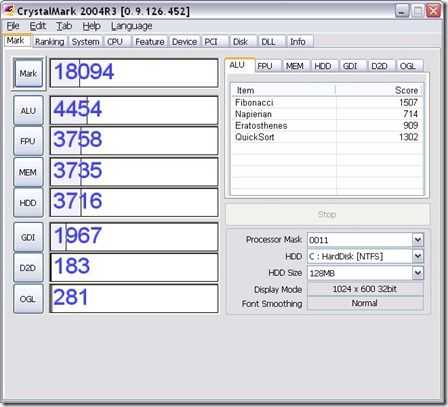
Crystal Disk Mark
In the Crystal Disk Mark scores above you can see the excellent results on the sequential data transfer test using large block sizes. Write speed is just average and 1.5MB/s at 4K blocks is just about acceptable. The results for the UMID BZ are shown below for comparison. Read speeds are much lower but it’s the 4K write speed that really affects usage. Write operations can ‘lock’ very easily causing a complete lock in the user interface. (The relatively small 512MB RAM on the UMID BZ is likely to contribute to this ‘lock-up’ problem too.)
Above: UMID BZ Crystal Disk Mark for comparison.
Crystal Mark test software is available here.
Video performance.
As with the Viliv S5, The Viliv N5 includes the Intel US15W chipset with the GMA500 GPU and video decoding hardware for H.264, WMV, MPEG4 and MPEG2. Viliv have also included some Cyberlink software and the K-Lite codec pack on the device and combined with Windows 7 support for multiple video types and hardware decoding the video performance is fantastic. We were able to run most of our test suite without problems.
- H.264 up to 1080p (12mbps average)
- WMV up to 6.5 mbps (720P)
- MPEG2 (DVB-T signal at about 3Mbps)
- M-JPEG (about 10 Mbps)
- MKV container with 6Mbps H.264 and multiple audio tracks Slight stutter (estimated 5% frame loss)
All tests were done with stock settings on Windows Media Player. We expect better results on 3rd party players with some tweaking (KMPlayer, GOMPlayer for example)
Viliv Player.
As an alternative to the Windows Media Player, Viliv have included their own player. Results are similar to Windows Media player although we did see some blocking and render problems with WMV videos. In general though, the media player performance is very good and the colors, sharpness and contrast are exceptional on the high-resolution screen.
[Note: Video playback results will vary with different files, filters, drivers and playback software]
As for inline flash video, the normal quality (360p) and HQ (480p) YouTube videos work well in both windowed and full screen modes. See below for more information on YouTube playback.
The Viliv N5 CPU is not powerful enough to show HD quality YouTube videos despite these being in H.264. The flash player does not link with the Intel hardware to enable hardware decoding. [Tip: YouTube HD videos can be downloaded with the help of 3rd party software and then played offline from the disk and outside the flash environment. ]
Audio.
Audio quality from the Viliv N5 speakers is acceptable for brief video clips and windows sounds but the Mono speaker (the speaker grill on the RHS is only for show) fails to deliver anything that could be classed as loud. The Viliv s7 is miles ahead in this area. The headphone jack provides a very clear and powerful signal and with the extensive equalizer on the audio module, tone can be finely adjusted. The Bluetooth stack is capable of A2DP too so there are good options for listening to audio tracks.
Bluetooth headset profile works and once the device is set as default it can be used with the mobile partner software for voice calling. We tested this successfully with an MSI Bluetooth headset module with integrated mic.
Heat and noise.
Viliv have designed the N5 without fan which results in silent operation. The device can get warm under load and we noticed it getting uncomfortable after testing a series of videos.
Stability.
During the three weeks that we tested the Viliv N5 we saw no indication of instability. Startup and standby operations were 100% without problem.
Boot-up, standby, hibernate speeds
Boot-up from cold requires about 1 minute. 75 seconds to Wi-Fi internet connectivity. Standby (return) is about 5 seconds with an extra 20 seconds for internet connectivity over Wi-Fi.
Hibernate takes about 1 minute and return from hibernate is a very respectable 20 seconds. (again, Wi-Fi connectivity taking another 15-20 seconds on top of that)
Battery life.
One of the common trade-offs with handheld devices is battery size vs. keyboard. This is obvious in the comparison between Viliv S5 and Viliv N5. The S5, a tablet device, is able to carry a 23wh battery. The N5 manages only a 16Wh battery in a similar weight. Clearly with a similar screen size and build, we can’t expect the N5 to have longer battery life than the S5 but at about 4hrs connected time, the N5 does well. Considering that the slate-style battery is so thin, a secondary would be very easy to carry.
Viliv claim up to 6hours battery life. This would be achievable with a low screen brightness and no Wi-Fi/3G connectivity.
In comparison the S5 with it’s 24wh battery provides 6hrs of Wi-Fi-on browsing which is exactly the same battery drain rate.
Battery drain on sleep seems very very low meaning the device will be available for many days before going into the frozen ‘hibernation’ state.
GPS.
A GPS chipset is included and appears on COM1 at 4800 or 9600 baud (configurable) Sensitivity seemed good with a signal lock available in good time outdoors (up to one minute.) Indoor use is possible but only where walls are thin. We were able to retain a signal near a window. The GPS driver is not Windows 7 sensor compliant and many applications such as browsers and social media applications are not GPS-aware.
Application tests.
- Firefox3.6 (cold startup time 4s) ,
- Chrome 5.0 (cold startup 4s)
- Tweetdeck (cold startup 11s)
- Windows Live Writer (cold startup 7s)
- Skype V5 Beta (cold start 12s) Video working smoothly in a test between Viliv S10 and Viliv N5. No audio feedback was heard but speaker volume was relatively low. Headphones recommended.
- YouTube works well. All normal quality (360p) YouTube videos tested well in windowed and full-screen mode. All HQ (480p) videos tested worked in windowed mode and in full-screen mode too which is better performance than we’ve seen on a 1.3Ghz Atom before now. We attribute this to Windows 7 graphics drivers and the new Flash version 10.1. Unfortunately 720p videos aren’t working smoothly but with 480p working so smoothly, there’s really no need to be watching 720p videos. CPU usage levels are high when watching YouTube so battery life will take a hit but for an hours casual browsing, the N5 provides a great experience.
Productivity With Open Office.
OpenOffice 3 installed and ran a basic word processing test with no problems at all.
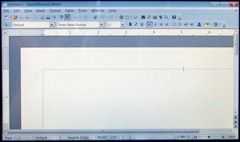
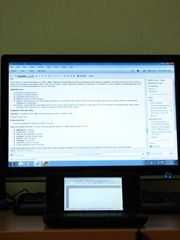
More detail on Open Office on the Viliv N5 coming in August.
Firefox load times.
- Firefox application startup time (cold): 4 seconds.
Page load examples (first load, no cache, full script and flash support over Wi-Fi. Signal strength 2-3 bars)
- UMPCPortal: 11 seconds
- Google News: 3 seconds
- CNN.com (international) 15 seconds
- Facebook 3 seconds to login screen
- uk.yahoo.com: 7 seconds
- Techmeme: 11 seconds
- Gmail (full version): 6 seconds
- Google Reader (633 items): 9 seconds
Overall, page loading times were fast and testing with Chrome 5 brought advantages of 2 seconds in most cases. Reloads on Firefox were also 2-3 seconds quicker.
Gaming.
We haven’t tested any games with the Viliv N5 and due to the relatively poor 3D performance figures, wouldn’t recommend this for modern gaming. Casual gaming will be fun as all keyboard can be used.
Wi-Fi/Bluetooth quality.
Bluetooth reception quality was not extensively tested. (File transfer, A2DP and headset profiles were tested OK) The system uses BlueSoleil version 5.4.281 which, in our opinion based on a number of devices running the same stack, supports most profiles, is stable and easy to use.
We had no problems at all with Wi-Fi configuration or reception. Reception appears to be average-to-good compared with other UMPCs and netbooks we’ve used. The Marvell sd8686 WiFi mofule only supports B and G modes.
Micro SD
Write speed 6Mbps tested on a Class 6 8Gb card. The card slots fully in with a spring-loaded release.
3G
The review device came with a Huawei EM770W modem installed. It is HSPA and voice capable. In tests we experienced good reception. A quick open-air test resulted in 3.37 Mbps download speed and 1.12 upload speed (O2 Germany, Location:Bonn)
Who’s the target customer?
With one of the highest quality desktop-style handheld computing experiences we’ve seen under 500gm, the Viliv N5 offers a lot for those looking to take Windows on the road. Where the S5 leant more towards media consumption, the N5 leans more towards getting emails,docs and creative processes done. Having said that, the N5, with it’s Win7 build outperforms the S5 in video playback. It’s a real all-rounder.
We see the N5 appealing to a wider range of users than the average ultra mobile PC because of the quality and form factor. A clamshell style is practical and understandable. A stylish one is even better. Those looking for a full Internet experience in the hand won’t find a much better solution than on the N5.
For support staff, this is the perfect remote access tool with guaranteed access to web-based systems, FTP and SSH tools and of course, remote desktop.
As a navigation device, the N5 would sit comfortably on a dashboard but the glossy screen and low brightness could be a serious problem in that scenario. Navigation software on PC’s isn’t free as it is on many Nokia or Android devices so you’ll be looking at another $100 for that software.
As a travelers and moblogging device we find the N5 quite attractive. It’s small, well connected and free of any hard drive. The clamshell format gives it natural screen protection and with the 5V DC input there could be some nice external batteries and solar chargers available. Live Gallery helps to manage and share photo’s on the go too. Those wishing to write an extended log might want to look at the netbook market though.
Limited disk space (11Gb Update: other owners report 13GB availailable from the 32GB drive) means that you won’t be storing your complete music and video collection on this which is a shame as it really would make a great backup PC for syncing to although there are some tiny 1.8 inch USB drives around now that go up to 250Gb storage.
For Skype video, the N5 is up there with UMID BZ as one of the most compact solutions on the market.
Photos.
More photos of the Viliv N5 are available in our gallery.
Summary
Thanks to the accurate mouse pointer, the N5 works well to get around many of the issues associated with using touchscreens with Windows operating systems. A fast SSD and 1GB RAM helps to speed up the experience too. Windows 7 Home Starter seems to work without any hitches at all. Battery life isn’t the best for the weight but at about 4 hours, it’s a good balance for a device with a full keyboard weighing just 400gm/14 oz.
The missing video output port is a mystery and will annoy many that were looking to take this on the road for presentations, those looking for a mini hotel PC and those looking to hook it up to a large screen for some occasional video playback experiences. With 1080p playback possible, it seems silly not to have exposed this through a video port.
High quality. Excellent build. Class-leading PC portability. Fast, high quality web browsing, high-end video quality and a a great keyboard make the Viliv N5 a confidence-inspiring package. It’s almost a repeat of the Viliv S5 but with the keyboard attached it opens it up to wider range of uses.
Pricing and availability
With a video-out port the N5 could have set new price/capability standards but unfortunately, it’s a case of Viliv pricing the N5 against the competition. We really can’t get over the lack of video output on a product that starts at $645 but if that doesn’t come into your checklist then you don’t need to worry as the N5 is best, most attractive handheld ultra mobile PC we’ve seen to date. Pricing for the 3G version goes up to $800 which we think is slightly too much of a premium to be paying for the ‘mobile’ in ‘ultra mobile PC’ so we hope to see those prices drop soon.
The N5 is available now through many of Viliv’s official partners.
Many thanks to Viliv for sending the N5 over and being available for questions.
Additional content:
Good discussion onViliv N5 vs UMID BZ
Review written on a solar-powered Viliv S10 netbook.

